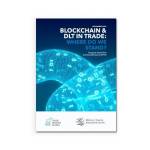Addressing the challenges to blockchain adoption in trade finance

Content
The large number of projects and initiatives operating in the DLT trade finance space naturally foments a “digital island problem” – that is multiple platforms that are unable to effectively communicate with each other.
As the industry continues to mature, it becomes increasingly clear that there is not going to be one network to rule them all. Instead, it is going to be a network of networks which means that interoperability will be key.
Interoperability and standardisation
The World Economic Forum (WEF) identifies business models, platforms, and infrastructures as the three key layers to DLT interoperability.
To ensure industry-wide value maximisation, firms and groups developing DLT solutions need to ensure that their solutions are designed from a standpoint that puts interoperability first and that establishes connectivity across each of these three layers.
Efforts also need to be made to develop global standards. Various organisations are working towards creating standards for DLT in trade, both general (e.g. the Digital Standards Initiative (DSI) of the International Chamber of Commerce (ICC) and the United Nations Centre for Trade Facilitation and Electronic Business (UN/CEFACT)) and specific (e.g. The Bankers Association for Finance and Trade (BAFT)’s distributed ledger payment commitment (DLPC)).
Ensuring that the standards being developed are widely accepted and span the entire supply chain will be of critical importance for the success of DLT projects in trade and trade finance.
The future trade finance infrastructure must be truly inclusive, with low barriers to entry for digitalisation.
It is critical that transaction information can be shared in a secure way, perhaps through digital documents.
Within shipping, mining, banking, purchasing, and other fields, there is a large number of industrial parties with different specialised platforms, each of which has its own rulebook.
For these to communicate effectively, the industry must agree on a coherent and uniform set of standards.
That said, the world is not static, and all transactions are unique, meaning that there will always be transactions requiring their own documentation even if most documents can be standardised.
For this, developments in artificial intelligence (AI) may come to be important.
Legal difficulties
A handful of significant challenges in the realm of DLT for trade finance lie in the legal arena.
First is the uncertainty surrounding the recognition of electronic signatures and electronic documents.
Not every country has established laws and standards regarding electronic signatures and digital transactions.
As a result, any transaction that must pass through one of these jurisdictions must resort to paper.
Another legal challenge is the general absence of legal recognition of digital negotiable instruments.
To remedy this, the United Nations Commission On International Trade Law (UNCITRAL) has developed a Model Law of Electronic Transferable Records (MLETR), which aims to enable the legal use of electronic transferable records both domestically and across borders.
The UNCITRAL MLETR provides a legal framework for the electronic/digital transfer of documents and negotiable instruments in electronic/digital form using DLT, which would provide harmonisation if adopted by key nations in trade and finance.
Released in 2017, the UNCITRAL MLETR has been adopted by only seven jurisdictions (as of October 2022 – see the UNCITRAL website for more recent updates): Bahrain (adopted in 2018), Belize (2021), Kiribati (2021), Papua New Guinea (2022), Paraguay (2021), Singapore (2021), and Abu Dhabi Global Market (part of the United Arab Emirates, 2021).
In October 2022, the UK introduced an Electronic Trade Documents bill into parliament.
Recognition of the legal validity and enforceability of electronic signatures and of documents such as electronic invoices is also being discussed in talks conducted by a group of WTO members in the context of the WTO Joint Statement Initiative on eCommerce.
As a result of the antiquated laws and regulations that remain in place in many countries, firms are forced to establish creative digital workarounds each time they seek to make a transaction in a new country.
This adds immense complexity to the overall process and reduces, if not outright eliminates, the effectiveness of DLT until such outdated policies are addressed and revised.
However, to overcome this problem, it will be important to find the right balance between over-regulation and under-regulation.
Most people are of the opinion that some regulation is necessary so there is a need to get the balance right.
The COVID-19 pandemic highlighted the need to revise legislation to allow and promote digital trade.
Many countries, such as the UK, are also indicated their intent to pass digital trade legislation, although at the time of writing these have not yet become law.
Unique needs may not be met
For small businesses, another challenge is that the solutions created may not meet their specific needs.
Due to the large upfront investment involved in creating functioning DLT networks, many of the products are naturally geared towards servicing big-ticket and high-volume customers, which offer the greatest potential return on investment.
This means that initiatives focusing on the specific needs of smaller enterprises may face profitability challenges before they are able to come to market and serve the critical mass of small clients required to generate sufficient revenues.
In May 2022, European-based we.trade, which focused on small businesses, went bankrupt for this very reason.
This ultimately means that smaller firms may be forced to contend with solutions that are not geared to their unique needs.
Data privacy concerns and long-term obsolescence
An additional consideration with regard to DLT as a connectivity technology is any legislation surrounding data protection and privacy.
As DLT can be made tamperproof, there may be difficulty removing information placed on the system.
Privacy laws, banking secrecy, and corporate secrecy are all issues that may arise if data that are subject to regulation are published on a DLT-platform.
To promote accessibility for corporates, DLT systems should establish connectivity and transparency only between the relevant parties.
Another concern for DLT development is that advances in quantum computing, while opening new opportunities, could also, in the long term, represent a threat to DLT, which relies heavily on encryption and algorithms to ensure resilience.
Important efforts are underway to develop post-quantum algorithms
- More About Blockchain
- Featured Insights















